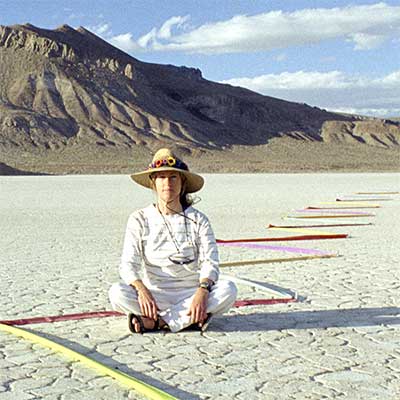Artist Statement
I am inspired by the relationship between humans and the water and land that sustain them. My work explores how landscapes change over time focusing on those places where destruction and renewal, wounding and healing, absence and presence overlap.
Growing up in Los Angeles during the drought years made me aware of the preciousness of water and that realization has turned into a passion for incorporating water related concerns into my art. I’m drawn to the birds-eye view of the landscape because of how it reveals human marks and patterns. My study of these marks leads me to ask questions about their history and how they may affect the health of our water ecosystems which we rely on to survive. For example, did this aqueduct contribute to the drying up of lakes or rivers and creeks? Does this landfill site or recent wildfire affect water quality? Could this dam have caused a species to become endangered or extinct? I research to find answers to those questions and to the many new ones that arise in the process - thus allowing me to more deeply understand the changes to the landscape and the environmental implications. My artwork is inspired and informed by my research process which includes the history, scientific studies, maps and aerial photographs of a site
I work in different mediums: textiles, land art installation and glass. In my textile work, I blend painting with quilting and embroidery techniques to create highly textured aerial landscapes and maps showing the human marks that affect our water resources. I choose to work in textiles for their versatility and familiarity. Silk, an alluring and lustrous fabric, is my primary medium because I can paint it with vibrant dyes and sculpt it through stitching to convey terrain. In consideration of the environmental message in my artwork, I want it to be approachable so I like the familiar and comforting feel of textiles that comes from the integral and basic part they play in our lives.
The process of making my work echoes the theme of destruction and renewal. I often begin by making a painting on silk where I commit many of the same destructive acts that humans have done to the landscape: I cut into the fabric, tear it, poke holes into it with needles; I build the equivalent of dams and dikes using resists to contain my liquid silk dyes. When the painting is done, I stitch it by machine and by hand, invoking the tradition of mending and repair through the act of sewing.
I use textiles as well as natural plant materials in my land art installations. In some installations I place textiles in dry landscapes to create the illusion of water. In others, the textiles and natural plant materials are used to illuminate the relationship between the present landscape and the past landscape.
I also work in glass, a medium that shares important properties with water such as transparency and interaction with light. Glass allows me to convey layers of meaning in my work by building up simultaneously visible transparent layers of design.
The aesthetic of beauty is important in all of my work; it helps make the serious and difficult nature of the subject matter I’m addressing more approachable.
